Robert Adams was a Master of Narrative Drive
The first ten novels in the Horseclans series by Robert Adams (Signet/
New American Library editions, 1979-1983). Cover art by Ken Kelly
Franklin Robert Adams (1933 – 1990) only used his middle and last name on his books. He wrote twenty-six of them, in three different series, and edited nearly a dozen more.
His first and most famous series is called Horseclans. It’s set on a post-apocalyptic Earth, after a nuclear war, and begins on America’s great plains with tribal groups organized along Native American lines. Later, it moves toward a more feudal society with city states and knights in armor. There’s a fairly elaborate back story about how the modern societies were built from the remnants of American survivors and some of the invaders.
The first book was called The Coming of the Horseclans and published in 1975. The last one published was #18, The Clan of the Cats, and it appeared in 1988, two years before Adams’ death. The series may be post-apocalyptic, but it’s long after Earth’s recovery has begun so it really feels more like standard Sword & Sorcery. There is some magic with undying heroes, telepathy, and “Witch” men. It’s definitely not Sword & Planet but most folks who like S&P like these pretty well.
The series was unfinished at the time of Adams’ death. I’ve got and read them all, which tells you that I enjoyed them. I’m starting a series on Adams today, although it won’t be as long as the Philip Jose Farmer series. I’ve included pictures of my copies of the first 10 above, one that I got without a cover. All had great Ken Kelly covers, and I’ve added a pic of the one I’m missing, Horseclans Odyssey (#7), below.
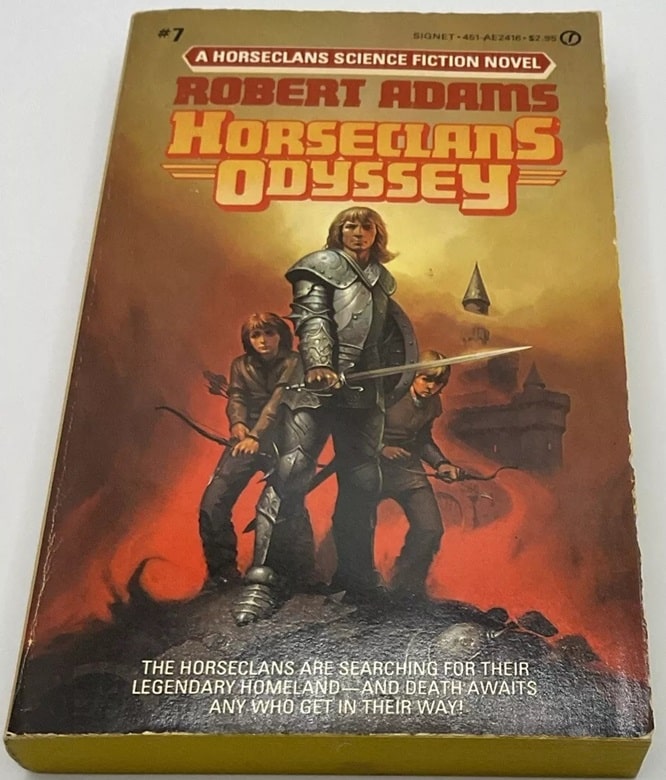 |
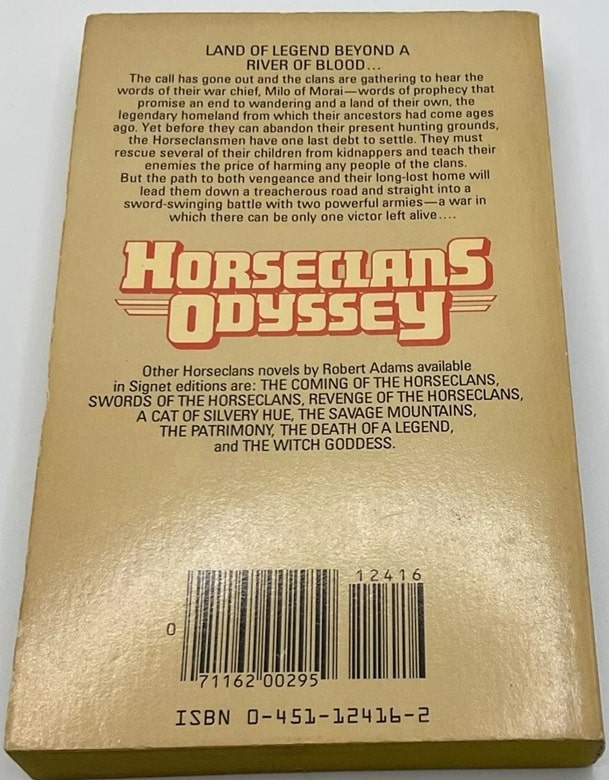 |
Horseclans Odyssey (Signet/New American Library, April 1981). Cover by Ken Kelly
The first book in Adams’ Horseclans series is called The Coming of the Horseclans. It introduces us to Milo Morai, who is one of the “undying” characters in the series. The undying are unaging and largely immortal unless they are drowned, burned to ashes, or decapitated. I often refer to this kind of character as Highlander types, although the movie Highlander wasn’t released until 1986.
Although that film’s writer has said that Ridley Scott’s 1977 film The Duelists was his inspiration, I’ve often wondered if there might not be some Robert Adams DNA in the conception as well. Of course, Adams may well have developed his concept of the “undying” from ERB’s characterization of John Carter, who also is said not to age.
Horseclans, Books 11-18 (Signet/New American Library, 1983-1988) and the anthology
series Friends of the Horseclans, Volumes I and II, edited by Pamela Crippen Adams
and Robert Adams (Signet/New American Library, 1987-1989). Covers by Ken Kelly
I remember reading the first Horseclans book and not loving it. The plot seemed kind of all over the place and the whole “undying” concept takes away a lot of tension. It’s hard to care about a character who generally cannot be killed.
Still, there were some fascinating ideas and a lot of action so I stayed with the series. Book 3, Revenge of the Horseclans, introduced a mortal character (although long lived) named Bili the Axe, and this was the turning point in the series for me. I really enjoyed the books with Bili in them, particularly one called Death of a Legend, and another called Bili the Axe.
The Horseclans series has a lot of graphic and barbaric violence in it, although probably true to the milieu in which it is set. The series also inspired two Friends of the Horseclans books, shown above, which are short story collections set in the same world with stories by Adams and others, including a tale by Andre Norton (No doubt due to the cats in the series.)
Overall, Adams had strong narrative drive and kept the stories rolling along with “one damn thing after another.” The stories are complimented by many strong Ken Kelly covers.
Castaways in Time (Signet/New American Library, 1982-1989). Covers by Ken Kelly
Adams’ second series started in 1979 with Castaways in Time. It ran to six books and I’ve read them all. I liked it, although not as much as the best of the Horseclans books. This isn’t S&P either, although it has some of the tropes.
A group of Twentieth Century Americans get caught on a small farm during a horrendous storm, and when the storm passes they are no longer on the Earth they knew. They whole farm has somehow been cast back into time to medieval England, although likely an “alternate world” England, where their modern weapons and technical know-how make them dangerous and powerful.
This is a concept that might have been borrowed from Philip Jose Farmer’s Two Hawks From Earth, which was published years earlier. Adams gets to rewrite history to make it more palatable to his beliefs. Again, his books scored some great Ken Kelly covers.
Stairway to Forever (Baen Books, September 1988 and January 1989). Covers by Ken Kelly
Adams’ last series was called Stairway to Forever. It started in 1988 but Adams only completed two books before he died. This is his closest effort to anything Sword & Planet. The books were both from Baen Books and published in 1988. They have excellent covers by Ken Kelly, and the covers illustrate the content.
A modern 20th century American named Alfred Fitzgilbert (Fitz) moves into an isolated house and uncovers a secret set of stairs that leads him to another world. At first that world seems uninhabited. It’s not. He discovers monsters and many strange characters but his modern weapons help him survive at first while later he essentially develops mental “superpowers.” There are hints throughout that Fitz may have fallen into what the ancients called “fairyland,” and there are certain elements that evoke Alice in Wonderland, particularly a talking (or telepathic) cat.
Book 2, subtitled Monsters and Magicians, continues Fitz’s adventures as he finds out more about why he was brought to this world, and what his mission is. I enjoyed both these books, although I wasn’t enamored with the “superpowers.” Still, the works showed a lot of promise.
As I mentioned above, Adams possessed “narrative drive” and his stories are always moving forward and always full of action. It’s too bad he didn’t get a chance to do more with these ideas. Not S&P, but fun.
Charles Gramlich administers The Swords & Planet League group on Facebook, where this post first appeared. His last article for Black Gate was Part III of his look at Chess in Sword & Planet Fiction, From Zelazny to Infinity.
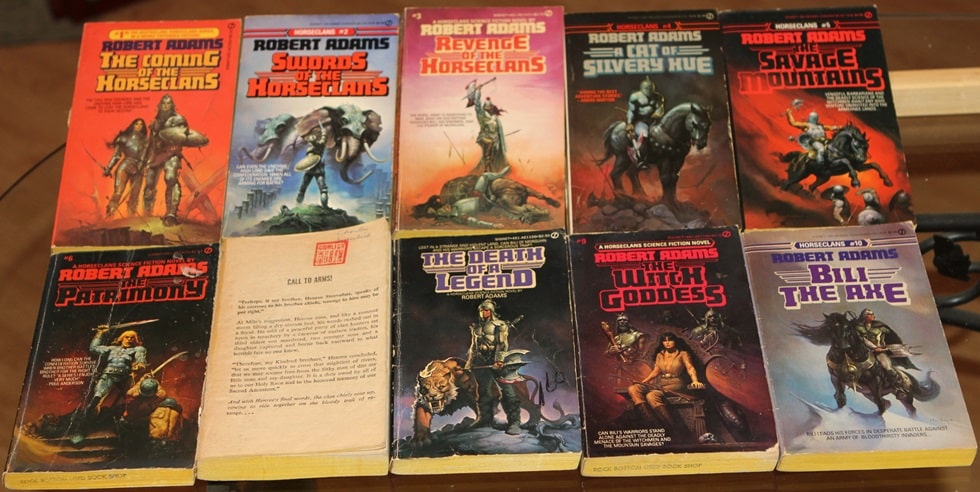
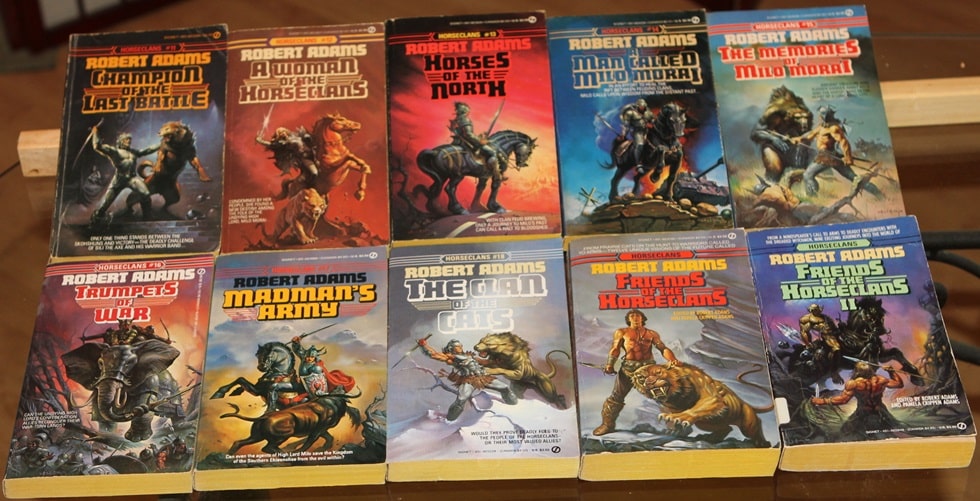
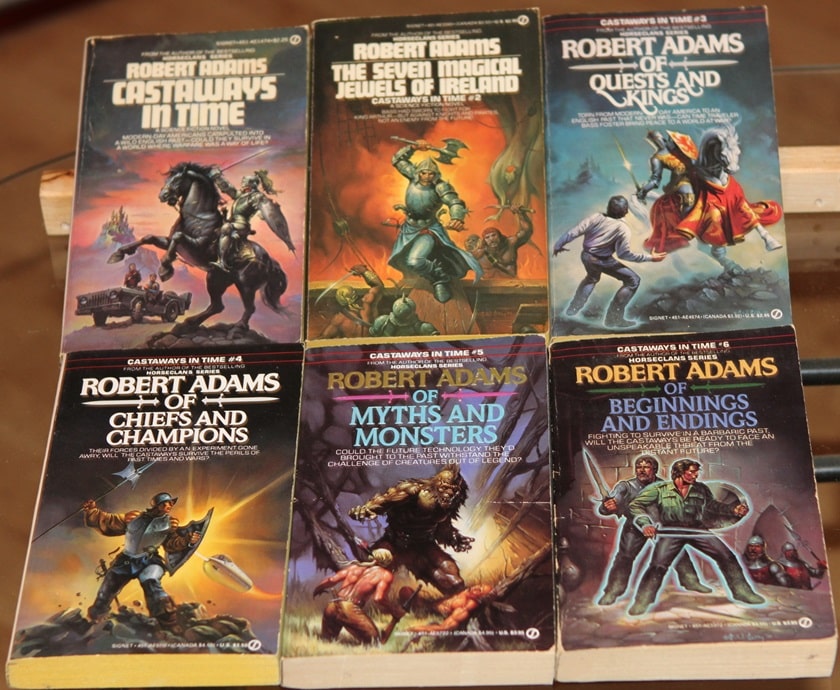
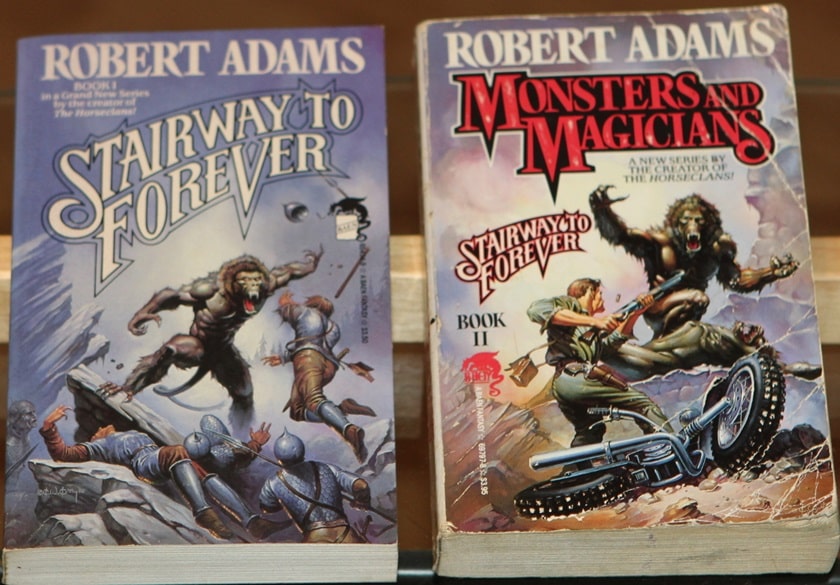
Thanks for the article. I read a couple of the the Horse Clans books back in the day. If I remember correctly, weren’t they written in reverse chronological order (each book was a prequel of the previous)? I haven’t read any of his other stuff – I will have to keep an eye out for them.
Hi JIm, not all of them were written that way. There are flashbacks in some books to earlier periods before the official start of the series. And there are books that are out of temporal sequence with the previous books, but many do follow a chronological order.
Another series I first discovered thanks to a review in Dragon Magazine. The first book I actually read was #7, Horseclans Odyssey, because it was a prequel so of COURSE I had to read it first. (That’s also why my first Deryni books were the Camber trilogy.) I never did read the full series — as I recall, I kind of lost momentum somewhere around Bili the Axe. Keep meaning to revisit them, but I’m honestly a bit afraid because I suspect parts of them have not aged well.
I do love the covers, though.
I might go back and try the Bili the axe tales again but generally there is just too much to read the first time to do much in the way of rereading
I grew up seeing these books on the spinner racks. Between the cover art and the titles, I just knew they were right up my alley.
However I got ahold if The Coming of the Horseclans, and I was really disappointed. I’m not even sure if I made it through the first book.
Maybe I needed to read them when I was younger.
the first book is one of the weakest and I wasn’t impressed with it either. But about book 3, when he introduced the Bili the Axe character, I really started to get into them.
Between the Ken Kelly covers and the names, I really really want to like them.
Thumbs up
Big fan of the series, and agree completely that Bili was the key. As a long time resident of western PA, I appreciated that “prince grade armor” came from “Pitzburgh “.
Yes, there were some nice nods to local histories throughout.
[…] (Black Gate): Franklin Robert Adams (1933 – 1990) only used his middle and last name on his books. He wrote […]